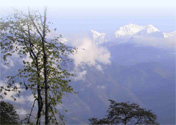International Nanotribology Forum
NANOSIKKIM-III: Mechanics and Friction at the Nanoscale
10–14 November 2008, Norbu Ghang Resort, Pelling, Sikkim, INDIA

International Nanotribology Forum |  |
|
VENUE NanoSikkim III will be held in Pelling under the shadow of the famous Buddist monastery of Pemayangtse. Located in the North Eastern part of India, Sikkim is easily accesible by air from Kolkatta (Calcutta) and New Delhi. The panoramic view of the Mt. Kanchenjunga and its lesser peaks from the Norbugang Resort, will provide a fitting backdrop for the meeting. Lose yourself in the verdant wilds of Sikkim by trekking, mountaineering and whatever else your heart wishes to do. Treat your taste buds to exotic Sikkimese dishes, inhale fresh, unpolluted Sikkimese air, and watch the intriguing lifestyle and charming ethinicity of Sikkim unfold in front of your eyes. Pelling Pelling, at an altitude of 2,085 m, presents breathtaking views of the beautiful Singalila range of the Himalayas. Pelling is on the state highway connecting Gangtok and Yoksum and rests at the foot of snow-capped Mt.Kanchenjunga (8,585m). The important Pemayangtse monastery is a few kilometers from Pelling and is situated on a hilltop (2,130 m) which is covered by moist temperate Oak forests decorated with moss and lichens. Sikkim Small but beautiful, Sikkim situated in the Eastern Himalayas spread below the world's third highest mountain Kanchenjunga (8,585m) revered by the Sikkimese as their protective deity. Sikkim is separated by the Singalila range from Nepal in the west, Chola range from Tibet in the northeast and Bhutan in the southeast. Rangit and Rangpo rivers form the borders with the Indian state of West Bengal in the south. Climate The climate of the state has been roughly divided into the tropical, temperature and alphine zones. For most of the period in a a year, the climate is cold and humid as rainfall occurs in each month. The area experiences a heavy rainfall due to its proximity to the Bay of Bengal. The rainfall in north district is comparatively less than of the other districts. The general trend of decrease in temperature with increase in altitude holds good everywhere. Pre-monsoon rain occurs in April-May and monsoon (south-west) operates normally from the month of May and continues up to early October. Temperature (min-max): Summer 13-21oC; Winter 0oC-13C
|
||||||||||||||||